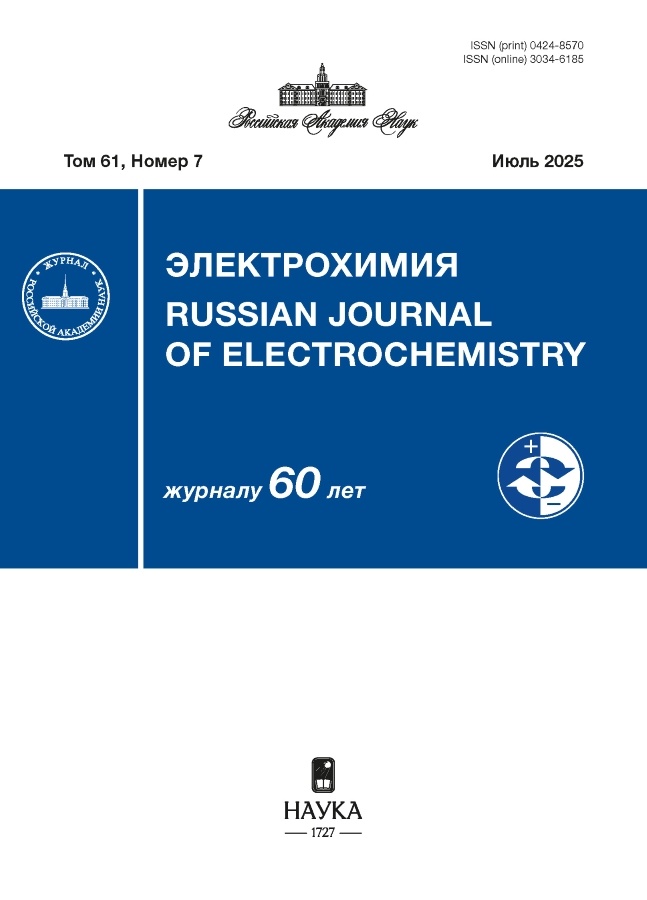Том 60, № 6 (2024)
Статьи
Адсорбция полипротеина Gag вируса иммунодефицита человека на липидных мембранах: исследование методом компенсации внутримембранного поля
Аннотация
Полипротеин Gag – это основной структурный белок вируса иммунодефицита человека (ВИЧ). Он ответственен за сборку новых вирусных частиц в инфицированной клетке. Данный процесс происходит на плазматической мембране клетки и, во многом, регулируется взаимодействиями Gag с липидным матриксом клеточной мембраны. В настоящей работе с помощью метода компенсации внутримембранного поля и электрокинетических измерений дзета-потенциала в суспензии липосом нами было изучено связывание немиристоилированого полипротеина Gag ВИЧ с модельными липидными мембранами. Для количественной оценки аффинности белка к заряженным и незаряженным липидным бислоям были получены изотермы адсорбции Gag и вычислены константы связывания. Показано, что данный белок способен взаимодействовать с обоими типами мембран примерно с одинаковыми истинными константами связывания (KPC = 8 × 106 М–1 и KPS = 3 × 106 М–1). Однако присутствие в липидном бислое анионного липида фосфатидилсерина значительно усиливает адсорбцию белка на мембране за счет дополнительного влияния создаваемого им поверхностного скачка потенциала вблизи мембраны (KPSэфф = 37.2 × 106 М–1). Таким образом, взаимодействие Gag с мембранами определяется, скорее, гидрофобными взаимодействиями и площадью, приходящейся на одну липидную молекулу, в то время как наличие отрицательного поверхностного заряда лишь увеличивает концентрацию положительно заряженного белка вблизи мембраны.
 387-398
387-398


Нанокомпозит графен-фосфореновых структур с фосфидом кобальта – эффективный электрокатализатор выделения водорода в кислой среде
Аннотация
Одними из наиболее перспективных электрокатализаторов реакции выделения водорода с точки зрения соотношения активности, стоимости и долговечности являются материалы, содержащие наночастицы фосфида кобальта. В работе представлен простой и эффективный подход для получения нанокомпозита графен-фосфореновых структур, декорированных наночастицами CoP с размерами 2–5 нм. Нанокомпозит был получен путем электрохимического расщепления черного фосфора с последующим сольвотермальным синтезом, осуществленным в присутствии допированных атомами азота малослойных графеновых структур в растворе, содержащем ионы Co2+. Установлено, что полученный электрокатализатор демонстрирует высокую активность и стабильность в реакции выделения водорода в кислой среде. Для достижения плотности тока 10 мА см–2 требуется перенапряжение ~220 мВ, при этом наклон Тафеля составляет ~63 мВ дек–1. Сделано предположение, что такой результат обусловлен как синергетическим эффектом взаимодействия между графеновыми и фосфореновыми структурами, так и электрокаталитической активностью наноразмерных частиц CoP, присутствующих на краевых участках фосфореновых структур.
 399-407
399-407


Электрокаталитические свойства водорастворимых фталоцианинатов никеля(II) и меди(II) в реакции окисления гидроксид-ионов
Аннотация
В настоящей работе методом циклической вольтамперометрии изучено электрохимическое и электрокаталитическое поведение золотых электродов, модифицированных тетра-4-сульфофталоцианинатами никеля(II) (NiPc) и меди(II) (CuPc), в водно-щелочном растворе. Дана сравнительная оценка электрокаталитической активности исследованных металлофталоцианинатов в реакции окисления гидроксид-ионов с образованием молекулярного кислорода, проведено сопоставление с данными литературы.
 408-414
408-414


Полищелочной эффект в стеклах различных классов в рамках модели микронеоднородного строения стекла
Аннотация
На примере силикатных стекол составов (33.3 – x) Li2O · xNa2O · 66.7SiO2 и (33.3 – x) K2O · xNa2O · 66.7SiO2 с чисто катионной проводимостью и халькогенидных стекол разрезов (Ag–Cu)0.33AsSe1.5 и (Ag–Cu)0.61AsSe1.5, обладающих смешанной ионно-электронной проводимостью, рассмотрена возможность описания проявления полищелочного эффекта в биметаллических стеклах в рамках модели микронеоднородного строения стекла при помощи аддитивных схем, использующих концентрационные зависимости электропроводности монометаллических стекол с содержанием одновалентных металлов, равным их содержанию в смешанном стекле. Показано удовлетворительное согласие экспериментальных и расчетных данных. При этом в щелочных силикатных стеклах нелинейное изменение параметров электропроводности связано с миграцией двух щелочных катионов и последовательной заменой проводимости с преимущественным участием одного иона другим. В исследованных халькогенидных стеклах аналогичное изменение электрических параметров связана со сменой основного типа носителя тока при эквивалентном замещении в объеме стекла серебра на медь: смешанная, преимущественно ионная проводимость сменяется чисто электронной.
 415-429
415-429


Электроосаждение фоточувствительных слоев на основе проводящих полимеров и фталоцианината цинка, их структура и фотоэлектрические свойства
Аннотация
Фоточувствительные гибридные слои были получены методом электрохимической полимеризации пиррола и 3,4-этилендиокситиофена (EDOT) в присутствии водорастворимой натриевой соли окта(3ʹ,5ʹ-дикарбоксифенокси)фталоцианината цинка (ZnPc), содержащей 16 ионогенных карбоксилатных групп. Установлено, что процесс электроосаждения гибридных слоев наиболее эффективно идет в гальваностатическом и потенциостатическом режимах на подслое комплекса PEDOT-поликислота. Изучены электронная и химическая структура, морфология гибридных слоев полипиррола (PPy), полученных в присутствии ZnPc. Рассмотрены возможные причины того, что измеренные значения фоточувствительности и внешнего квантового выхода генерации носителей заряда в PPy-ZnPc выше в несколько раз, чем в PEDOT-ZnPc.
 430-441
430-441


Синтез, ионная подвижность и проводимость композитов на основе дифторидов олова и свинца по данным ЯМР 19F и импедансной спектроскопии
Аннотация
Методами ЯМР 19F и импеданса изучены ионная подвижность и электропроводность в композитах и соединениях эвтектического и близких составов, полученных различными способами в системе PbF2–SnF2. Рассмотрены этапы трансформации спектров ЯМР 19F полученных образцов, их связь с видами ионных движений и возможные факторы, оказывающие влияние на величину ионной проводимости. Установлено, что в состав большинства композитов входит флюоритовая фаза, обладающая высокими значениями ионной подвижности и проводимости. В области, близкой к эвтектической, был впервые получен однофазный образец со структурой флюорита. Величина удельной проводимости полученной фазы (5 × 10–3 См/см при 390 K) позволяет рассматривать последнюю в качестве основы для получения функциональных материалов.
 442-451
442-451


Анодное формирование и фотоэлектрохимические характеристики оксида Ag(I) на сплавах системы Ag-Pd
Аннотация
Оксид серебра (I) рассматривается как один из перспективных материалов для фотоэлектрохимических технологий, поскольку характеризуется оптимальным значением ширины запрещенной зоны, относительно невысокой стоимостью и широким спектром способов получения. Однако такие его характеристики, как квантовая эффективность, параметры морфологии и кристаллической структуры, требуют оптимизации, которую можно достичь, применяя наиболее подходящий способ получения материала. Одним из достаточно простых способов является анодное окисление серебра или его сплавов в щелочной среде, позволяющее получать оксидные фазы контролируемого состава и с прогнозируемыми свойствами за счет варьирования концентрации компонентов сплава и режима электролиза. Цель данной работы – выявление особенностей анодного формирования и определение фотоэлектрохимических характеристик оксида серебра (I) на сплавах серебра с палладием в деаэрированном 0.1 М KOH. Закономерности анодного формирования оксида Ag(I) на сплавах системы Ag-Pd с атомной долей палладия от 0.05 до 0.20 в деаэрированном 0.1 М KOH исследованы нестационарными электрохимическими методами циклической вольтамперометрии, хроноамперометрии с синхронной регистрацией фототока и измерения фотопотенциала. Фазовый состав сплавов (альфа-фаза) определен по результатам рентгеновской дифрактометрии, химический состав – по результатам энергодисперсионного микроанализа. Фотоэлектрохимические параметры рассчитаны по результатам измерения фототока и фотопотенциала. Установлено, что оксид Ag(I), анодно сформированный на сплавах серебра с палладием, характеризуется n-типом проводимости и преобладанием донорных дефектов. На сплавах с относительной низкой концентрацией палладия (5 и 10 ат. %) формируется оксид Ag(I) с более высокой концентрацией дефектов, тогда как на сплавах с относительно высокой концентрацией палладия (15 и 20 ат. %) – с более низкой концентрацией дефектов, чем на серебре.
 452-463
452-463


Памяти Веры Александровны Богдановской (10.09.1942–05.05.2024)
 464-464
464-464










